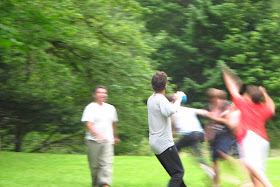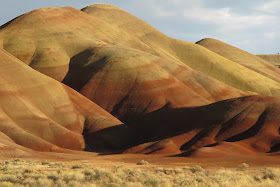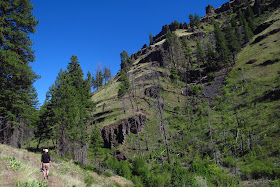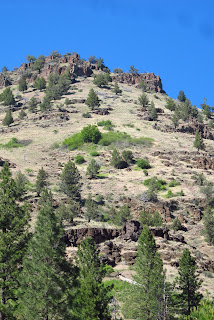The Rogue River became popular in the 1920s thanks to the work of American author Zane Grey, who built a small cabin on the banks of the Rogue so he could write in peace and fish when he wanted (he was a champion fisherman.) One of his novels, Rogue River Feud, was published posthumously in 1948 and depicts hair-raising adventure and intrigue along the river, typical of Grey's Westerns. Ironically, Grey left his cabin on the Rogue in 1935 and moved north to the Umpqua River, because he felt the Rogue was becoming too popular, in part because of the attention his presence had brought to it.


We arrived on the Rogue on June 25th and camped out at the Griffin Park CG along the banks of the river. We watched osprey and eagle hunt fish and nighthawks cruise for insects no more than a few feet above the water. The next day, June 26th, was Giovannina's birthday. As a treat, I signed us up for some horseback riding. Giovannina grew up with horses, but hadn't been on one in years. I have never been around horses and had no idea what I had gotten myself into. But our guide, Mike, was very patient and so were the horses. Mike took the lead on Beau, while I was on Ace and Giovannina got to ride Kucina. I never thought such big animals could be so docile1 Mostly, I had to pull Ace's head up to keep him from eating too much grass. The six of us rode through tall stands of sugar pine, growing 150' or more, and strolled through an old meadow, the remnants of an abandoned homestead. We almost caught sight of a herd of elk, but they disappeared before we could spy them. It was a great way to spend an afternoon and I think Giovannina enjoyed her equine birthday present.

That night we had dinner at Morrisons Lodge on the Rogue. We chose Morrisons because our friend James Sampsel works as a fishing and rafting guide for them. We met James at the Cajon del Azul trailhead in El Bolson, Argentina back in February. He had said to drop him a line if we were ever passing through Oregon, so we took him up on it. Great guy and great host. He set us up with Mike for the horseback riding, gave us a place to crash and drove us to the trailhead to begin our hike of the Rogue River. In addition to being a rafting and fishing guide, James is also an artist. You can check out his work at http://james-sampsel.com/.
We began hiking the Rogue River trail on June 27th. By 10 am the sun was already hot and the river's waters were looking a lot more appealing than the poison oak infested trail. We envied the rafters, floating lazily downstream, their boats carrying hundreds - seriosly HUNDREDS - of pounds of gear, while we hoisted our packs to begin the 40 mile trek from Grave Creek to Ilahee. We planned to spend four days hiking the river, but gave ourselves an extra day just in case.



Despite the ubiquitous poison oak, which sometimes filled the trail, the hike was wonderful. We worked our way along the cliffs, which gave views down into the river while also offering vistas of the surrounding Siskiyou mountains. Every few miles we would cross tributaries trickling there way to the Rogue. These smaller, quieter streams often had campgrounds, waterfalls and great swimming holes. The trees along the trail were exquisite. Seriously. Unlike the Cascades, the Siskiyous have a great mix of both wet and drought-tolerant species, so not only did we get plenty of Douglas Firs and Western Hemlocks, but also large, majestic Madrones, their red-orange trunks twisting above the cliffs and whole groves of Live Oaks, stately trees with kingly crowns and moss-lined trunks that left dappled shadows across the trail.


The first day was the only hot one of our journey. After that, the weather cooled, which was actually much nicer for hiking. We planned to hike about 10 miles a day, but the rolling trail without any big climbs combined with the stunning scenery invigorated our legs and we did 14 miles the first day. This may have been a mistake, however, as Giovannina had a large blister and half way through the trip she took to wearing my shoes as an alternative to rubbing the same spot - I hiked in my sandles - even though they're five sizes too big.
The next day we met up with the rafters again - we were taking a lunch break and they pulled up at our same spot. After reminiscing about the night before we talked some more and found out that they knew Roger Ogren (a co-worker of Giovanninas at the Aquarium) Roger has even rafted the Rogue with them years ago and they all said to say hi. Hi Roger from your old roomate Glen and gang.


Our last night on the Rogue was at Flora Dell, a beautiful little rock outcrop right on the river. We set up camp and bathed in a cold, clear pool from one of the side creeks, salamanders scurrying beneath our nakedness. We made dinner and Giovannina soaked her feet in the cold water as we sat and watched the sun go down over the mountains, dark green, mist covered hills slowly fading from view in the distance.
The next morning we were greeted with two surprises. The first was rain, which dampened our moods and made hiking in blistered feet all the more painful. The second was a large group of rafters who came to Flora Dell to jump off one of the rock promintories. So much for solitude. We took both of these as signs that it was time to move on, and so we hiked the last five miles out to our car, which had been shuttled - for a $100 fee - to the Ilahee parking lot. We got to the car, packed up, put on clean shirts and hit the road for Corvallis, where we met up with our friends Mike and Julie, had ourselves a burger and a beer or two, and treated ourselves to the most wonderful of modern conveniences - a hot shower.

































